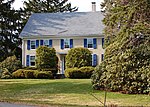Ipswich River Wildlife Sanctuary
Essex County, Massachusetts geography stubsMassachusetts Audubon SocietyMassachusetts geography stubsNature centers in MassachusettsNortheastern United States protected area stubs ... and 3 more
Protected areas of Essex County, MassachusettsUse mdy dates from June 2022Wildlife refuges in Massachusetts

The Ipswich River Wildlife Sanctuary, which is one of the Massachusetts Audubon Society’s largest wildlife sanctuaries, is located in Topsfield and Wenham, Massachusetts. Much of its 1,955-acre (7.91 km2) landscape was created by a glacier 15,000 years ago.
Excerpt from the Wikipedia article Ipswich River Wildlife Sanctuary (License: CC BY-SA 3.0, Authors, Images).Ipswich River Wildlife Sanctuary
Geographical coordinates (GPS) Address Nearby Places Show on map
Geographical coordinates (GPS)
| Latitude | Longitude |
|---|---|
| N 42.624444444444 ° | E -70.909444444444 ° |
Address
South Hamilton
01982
Massachusetts, United States
Open on Google Maps











